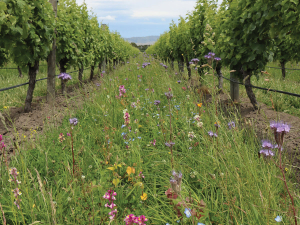"But now we know what different plants bring to the soil; through trial and error, through collaboration and talking with researchers." A decade ago, a Blenheim-based opportunity brought Jeremy back to his home town from Gisborne. When the job fell through, he and his wife Alice set up Osgro, a bespoke seed production service working throughout the primary sector from horticulture - with the likes of Puro in Kekerengu - to foresty, farming and viticulture.
Over time, as their expertise developed, a corresponding interest in cover crops across the viticulture sector was also growing. "In the early 70s there was a huge amount of work done in this area," says Jeremy. "I spent two days with a retired researcher from the old DSIR whos work has never really been used, it just sat on the shelf - but now that knowledge is valuable."
The key to success is understanding the setting, he says. "Of course, people can buy off the shelf, but if vineyards want a specific outcome, they can get a crop designed for that, taking into account their soil needs, neighbouring vineyards, what their desired outcome is. We sit down with the grower to understand the landscape, and what their expectations are. Some are focussed on flavour, others want tonnage; all are driven by the soil."
As well as cover crops, Jeremy is keen to find a way to solve the problem of what to plant under the vines, helping vineyards move away from spraying.
"We know that grass under vines compromises the yield - there's no two ways about it. In the perfect world we would have living mulches, not competing with the vines, not compromising yield and delivering organic matter." After talking with Australian counterparts, Jeremy imported some potential living mulch species into New Zealand to trial. "For example, we brought in a variety called Angel Medic which is a low growing annual legume that is used in Australian vineyards. It's early days and it's a work in progress but it's looking very promising."
Jeremy and Alice are conscious that the environmental spotlight is on the entire primary sector, so are focussed on continuous innovation across all parts of their business. "The writing was on the wall with plastic bags going out of use. We knew there had to be a better way. We talked to our supplier, and they came back to us with a seven-ply paper bag for packaging our seeds. Recently we gave up our polypropylene seed sacks for paper bags. We are the first seed retailer in New Zealand to do this. We've taken that leap of faith and are giving it a crack."












